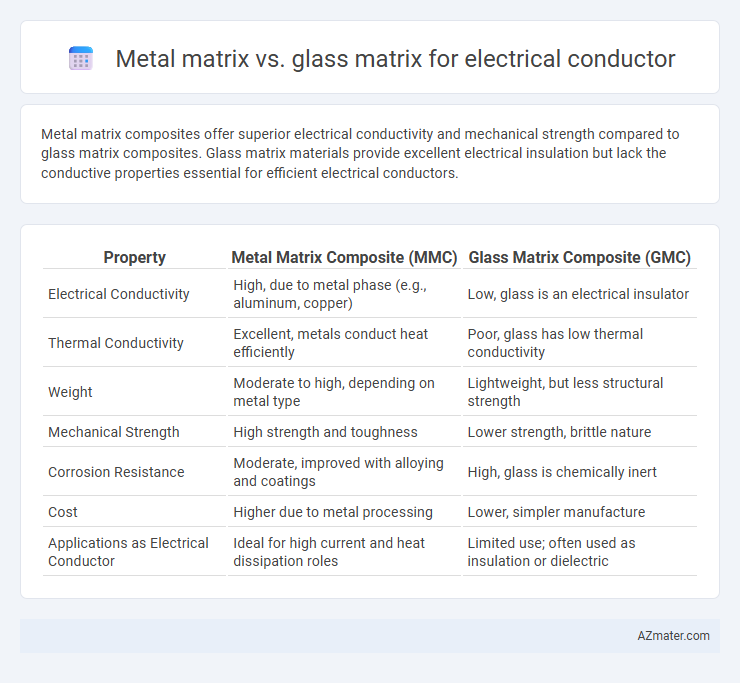Metal matrix composites offer superior electrical conductivity and mechanical strength compared to glass matrix composites. Glass matrix materials provide excellent electrical insulation but lack the conductive properties essential for efficient electrical conductors.
Table of Comparison
| Property | Metal Matrix Composite (MMC) | Glass Matrix Composite (GMC) |
|---|---|---|
| Electrical Conductivity | High, due to metal phase (e.g., aluminum, copper) | Low, glass is an electrical insulator |
| Thermal Conductivity | Excellent, metals conduct heat efficiently | Poor, glass has low thermal conductivity |
| Weight | Moderate to high, depending on metal type | Lightweight, but less structural strength |
| Mechanical Strength | High strength and toughness | Lower strength, brittle nature |
| Corrosion Resistance | Moderate, improved with alloying and coatings | High, glass is chemically inert |
| Cost | Higher due to metal processing | Lower, simpler manufacture |
| Applications as Electrical Conductor | Ideal for high current and heat dissipation roles | Limited use; often used as insulation or dielectric |
Introduction to Electrical Conductors
Metal matrix electrical conductors offer high electrical conductivity and excellent mechanical strength, making them ideal for demanding applications like power transmission and electronic components. Glass matrix conductors provide superior insulation properties and thermal stability, often used in high-voltage or harsh environmental conditions where dielectric performance is critical. Comparing metal and glass matrices highlights a trade-off between conductivity and insulation, influencing the choice depending on application requirements and operational environments.
Overview of Metal Matrix Conductors
Metal matrix conductors offer superior electrical conductivity combined with enhanced mechanical strength and thermal stability compared to glass matrix conductors. These conductors typically consist of metals like copper or aluminum reinforced with ceramic or carbon fibers, resulting in improved performance in high-temperature and high-stress environments. Their widespread use in electrical and electronic applications is driven by their ability to maintain conductivity while providing increased durability and resistance to thermal expansion.
Overview of Glass Matrix Conductors
Glass matrix conductors exhibit high electrical insulation combined with excellent thermal stability, making them suitable for high-voltage applications where minimizing electrical losses is critical. These conductors incorporate conductive metal particles within a glassy, non-conductive matrix, enhancing resistance to corrosion and mechanical wear compared to traditional metal matrix conductors. The inert nature of the glass matrix provides superior dielectric properties and improved longevity in harsh environmental conditions, optimizing performance in advanced electrical insulation systems.
Material Properties Comparison
Metal matrix composites (MMCs) offer superior electrical conductivity with high thermal stability and mechanical strength, making them ideal for high-performance electrical conductors. Glass matrix composites provide excellent electrical insulation, chemical resistance, and low thermal expansion but lack the conductivity required for efficient current transmission. The choice between metal and glass matrices depends on balancing conductivity needs with environmental durability and mechanical requirements in electrical applications.
Electrical Conductivity: Metal vs Glass Matrix
Metal matrix composites exhibit significantly higher electrical conductivity compared to glass matrix materials due to the intrinsic conductive properties of metals such as copper or aluminum. Glass matrices act as insulators, severely limiting electron flow and resulting in minimal electrical conductivity, which restricts their use in electrical conductor applications. The superior conductivity of metal matrices makes them ideal for high-performance electrical components where efficient current transfer is critical.
Thermal Stability and Performance
Metal matrix materials exhibit superior thermal stability and electrical conductivity compared to glass matrix composites, making them ideal for high-performance electrical conductors exposed to elevated temperatures. The metal matrix's ability to dissipate heat efficiently reduces thermal expansion and improves overall performance under thermal stress. Glass matrix conductors, while offering good insulation properties, typically suffer from lower thermal stability and conductivity, limiting their use in high-temperature electrical applications.
Mechanical Strength and Durability
Metal matrix composites for electrical conductors exhibit superior mechanical strength due to their metallic bonding and enhanced load-bearing capacity, offering excellent durability under cyclic stress and thermal expansion. Glass matrix composites provide high electrical insulation but suffer from brittleness, making them less durable in mechanical stress applications. The metal matrix's toughness and resistance to fracture make it more suitable for enduring harsh environments and mechanical wear compared to the fragile glass matrix.
Cost and Manufacturing Considerations
Metal matrix composites offer lower material costs and simpler fabrication processes compared to glass matrix composites, which typically involve higher raw material expenses and complex manufacturing techniques. Metal matrices provide superior electrical conductivity and thermal management, enabling cost-effective mass production with established metalworking technologies. Glass matrix composites require specialized equipment and longer processing times, increasing manufacturing costs and limiting scalability for electrical conductor applications.
Application Suitability and Industry Use
Metal matrix composites offer superior electrical conductivity and mechanical strength, making them ideal for high-performance applications in aerospace, automotive, and electronics industries where durability and thermal management are critical. Glass matrix composites provide excellent electrical insulation and chemical resistance, suitable for harsh environments in telecommunications, power transmission, and sensor technologies. Industries prioritize metal matrices for efficient current conduction and heat dissipation, while glass matrices excel in applications requiring electrical isolation and environmental stability.
Future Trends in Conductor Material Development
Metal matrix composites in electrical conductors offer superior electrical conductivity and mechanical strength, while glass matrix composites provide enhanced thermal stability and insulating properties. Future trends emphasize hybrid materials combining metallic conductivity with glass-based insulation for improved efficiency in harsh environments. Advances in nanomaterials and additive manufacturing techniques are driving the development of multi-functional conductors optimized for high-performance and sustainability.

Infographic: Metal matrix vs Glass matrix for Electrical conductor
 azmater.com
azmater.com